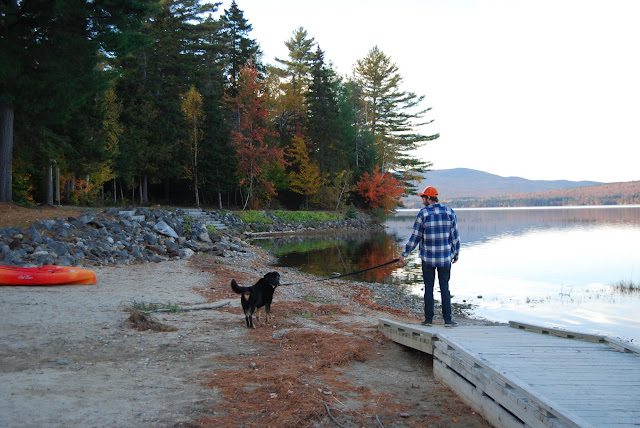View from parking near summit trail.
For my history of Maine class at USM I have been given the task of visiting places around the state. On October 11th, the first place I went to was Mt. Blue State Park, in the town of Weld, Maine. The area is roughly two hours north of Portland, near the town of Farmington. According to the Maine Bureau of Parks and Land's website, the land was given to the state in 1955. Before this it was ran by the U.S. Department of Agriculture, who acquired the land as a WPA project during the Great Depression.
However, do to too much antique shopping by myself on the drive up, as well as a refusal to use a GPS took up most of my time getting there. Therefore I didn't have time to climb the summit trail of the mountain before sunset. Should I actually researched the park before going I also would have known the trail was closed for repair. This actually made the trip much more enjoyable. In order to try to find another trail that I did have time to do, I drove many of the dirt roads in the area. Many of these appeared to be current logging roads, with small patches of trees missing. One road had a small cabin that appeared to be very old, but eventually just led to a small church camp, which was very strange in itself. Regardless, it was still very interesting to see a part of the state I have never been.
Dirt road and empty bible camp in the woods.
Eventually the driving led me to Webb Lake. The area was closed the day before, leaving it empty. I had to park on the side of the road and walk in. The view from the pond was great. You could see all the mountains in the area. It was also great for what you couldn't see. No people, very few houses on the lake, no jet ski's, no Canadians, and no development. You really got a feeling this was true rural Maine, an area that still lived on the land and not in the office. I learned that hope for Maine turning into a giant industrial park or housing development wasn't totally lost (if the gas station still ran by an attendant didn't convince you), you just have to drive 3 hours to see it. Even better, was that due to my own poor management of time I managed to get to the lake at sunset, which was prime for touristy leaf peeping as it was.
Yours truly with dog truly at Webb Lake.
Webb Lake at sunset.
Historical Significance of Weld, Maine and Mt. Blue State Park.

As said above, Mt. Blue was first purchased by the USDA during the Great Depression. Before becoming the state park, the area was settled around 1800. According to Geo J. Varney’s History of Temple, Weld, and Wilton, Maine (http://history.rays-place.com/me/franklin3.htm) as of 1886, the town was still home to five saw-mills. The area also produced other small items. The area, while not destitute, does not appear to ever have been a particularly thriving town. It was certainly never a Bangor, and certainly isn’t now.
Then why is this area historically significant? It never had a major factory, never had a population far over a thousand people, never had a particularly famous citizen (in 1886 Varney says the most esteemed citizen is a doctor), had no major tourism industry , and never became super wealthy. I believe that the area is important to the history of Maine for all those exact reasons. It is still very much that way, and for me, who rarely sees Maine out of the greater Portland area, it appears to be the quintessential Maine town. These are the towns that built our state, one small contribution at a time. Small towns, connected by small roads, with houses not set up in neighborhoods, but set back from the road by mile long dirt driveways.
For me this area gives more representation of how out state was, what attracted people to it, made it once thriving, and how it should stay than most of the places I see day to day around Portland.













